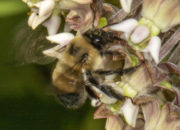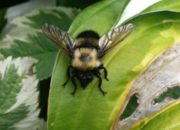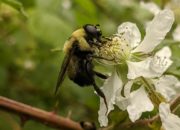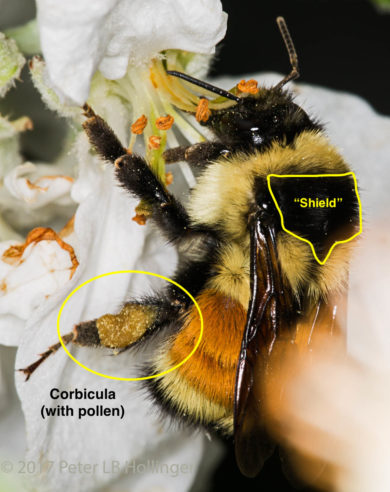With 17 species known from VT, and significant caste-level and individual variation, this genus can be daunting to ID, even in a limited geographic area. Not all individuals will be identifiable in the field, though with experience and good photos it is possible to rapidly ID many of the individuals likely to be encountered.
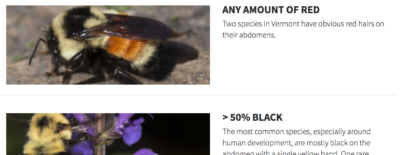
Simplified Online Key
Covers all the species likely to be found in the northeastern US. Designed to help ID live bumble bees from photographs. Explore »
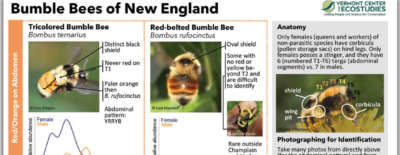
Two Page Field Guide
Covers the common New England Bumble Bees in a pocket-sized format. View and Download »
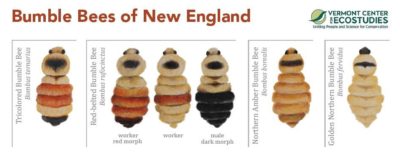
Illustrations
Original drawings for 16 New England Bumble Bees Check it out »
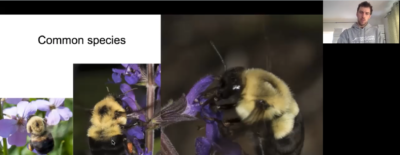
Video
Watch Spencer Hardy discuss New England Bumble Bee ID Watch here »
Bumble Bee Background and General Identification Information
Bumble bees are a genus (Bombus) in the order Hymenoptera. Unlike most of the native bee groups in the state, they are social insects with colonies and castes. Queens are the only castes to survive the winter. Having mated in the fall, they establish new colonies in the spring, then produce workers, and eventually males and new queens towards the end of the colony’s life. A small subset of species are parasitic, meaning their queens take over the colonies of other species, and as a result do not have a worker caste.
Queens and workers are both females and in the non-parasitic species have corbicula on their hind legs for collecting pollen. Males only exist for a short time at the end of the colony’s life cycle (July through October depending on the species). Males are generally hairier and lack the stinger, thus are safe to handle. With some trickier specimens, identifying the caste can be helpful for species ID. Sex can be added as an annotation on iNat, which can be used to sort images and mapped on the phenology graphs.
Other identification resources
- Discovery Life – Bumble Bee Key
- Bumble Bees of North America: An Identification Guide
- Bumble Bees of the Eastern United States (PDF)
- Minnesota Bumble bees: females and males.
- Species profiles from VCE’s Bumble Bee Atlas
Other Natural History Resources
Look-a-likes and mimics
Because bumble bees are a conspicuous part of many ecosystems and have a painful sting, they have inspired many different mimics. Some are quite convincing, even as species-specific mimics. A few are shown below, but there are insects in several orders that could easily be mistaken for a bumble bee. These are still valuable observations – please add your photo-observations of these, and all your biodiversity discoveries, to the Vermont Atlas of Life on iNaturalist.
Important Morphology
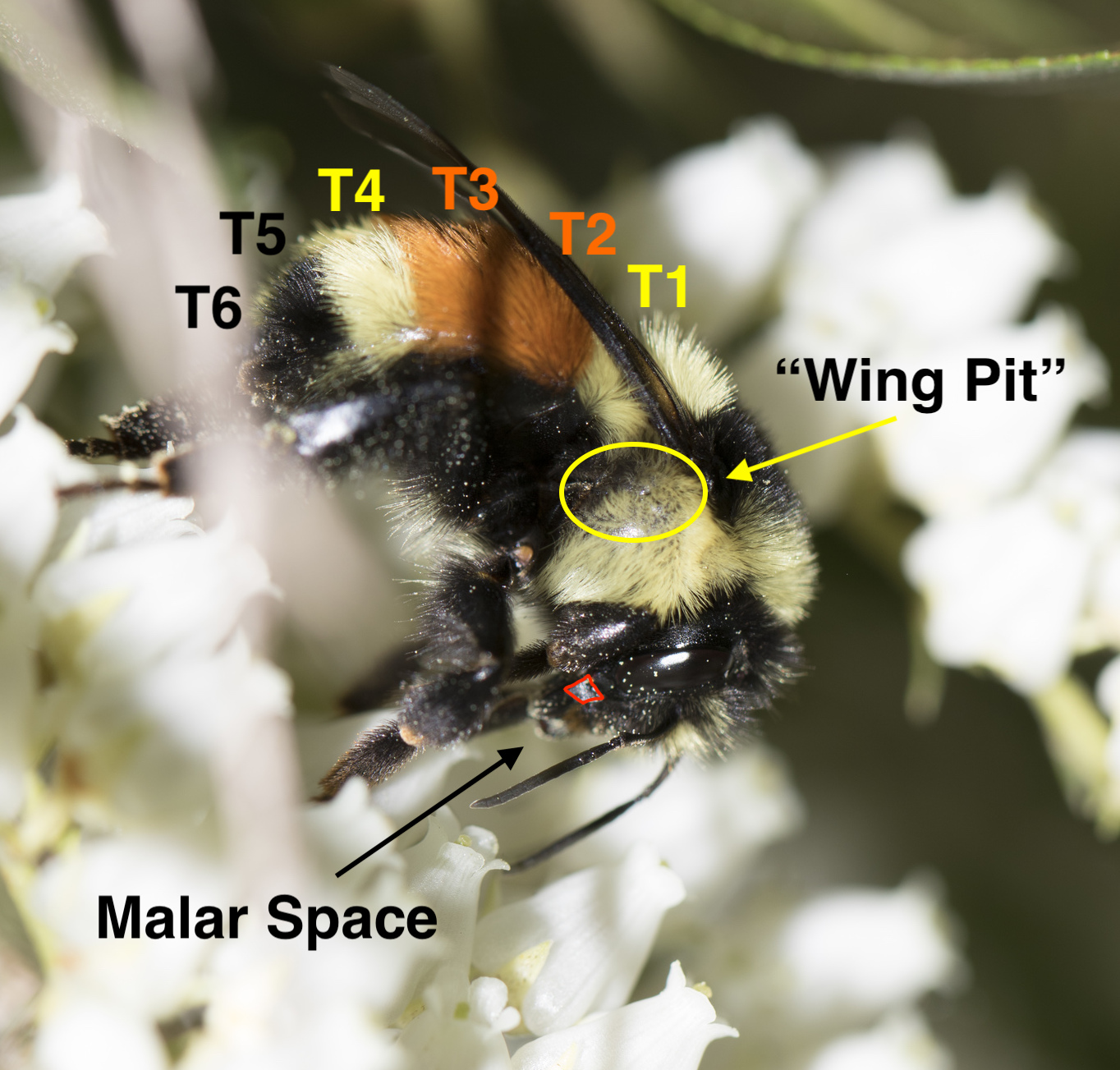
Photo © Kent McFarland
Terga
The abdomen of all bees is split into 6 (females) or 7 segments (males) called terga. T1 is the segment closest to the head. The actual distinctions between the segments can be hard to see, but hair color usually maps pretty closely, thus it is useful to refer to the color of each terga.
Wing Pit
Hairs on the side of the thorax behind where the wings attach. These haris are either predominantly yellow or predominantly black.

Variation in malar space ratios. Left to right: B. rufocinctus (~.5), B. ternarius (~1), B. fervidus (~2). All photos courtesy USGS Bee Inventory and Monitoring Lab.
Malar Space
The technical term for a bee’s cheek. Within Bombus the ratio of length to width varies considerably and is an important ID feature. The ratio is often expressed as W:L and varies from roughly 1:2 to 2:1.
Thorax
The thorax is the segment between the head and the abdomen. In most VT bumble bees, it is hard yellow with black hairs in the center. The black mark varies from practically non-existent to a large shield shape and is often useful for ID. Males generally have more yellow hairs and thus less distinctive black marks on the thorax.
Corbicula
Females of the non-parasitic species have modified structures on their hind legs for collecting pollen. The center of the hindleg is hairless and shiny and surrounded by longer hairs.The presence or absence of pollen in the corbicula is a useful phenology indicator.
Photographing tips
Photographing bumble bees is the best way to get positive identifications (without collecting). Getting multiple photos from different angles is preferable, with the most important shot being from above, ideally with the wings spread, as the abdomen pattern is important for most species. Face and side shots are also helpful. Recording videos and later selecting the best frames is a great way to make sure you capture all the field marks. As with other wildlife, moving slowly and being patient make getting photographs much easier. It is often possible to approach within a few inches of a feeding bumble bees (especially workers and males). General bee photography tips and tricks can be found here.
Preferred flowers
All bumble bees are generalists so can be found on a wide range of flowers, especially considering that some species are active from April to October. However, some flowers are more attractive to certain bumble bee species and some sites there is significant flower segregation by species. Flower associations can (and should) be added to bee observations on iNaturalist.
Subgenera
Within Vermont, there are 5 subgenera within the genus Bombus. These groupings represent genetic similarities and can be helpful in narrowing down the options when identifying tricky individuals. Morphological features such as eye size and hair length are relatively well conserved within these groups. The Pyrobombus subgenus is far and away the most common in the state, and is a good basis to compare too. The malar space of Pyrobombus varies from roughly square (1:1 ratio) to slightly longer than wide (1:1.5 ratio). Other groups have more extreme ratios (both smaller and larger). The subgenus Psithyrus includes all the parasitic species in the state and are distinctive in their lack of corbicula (they have no need to collect pollen).
Written by Spencer Hardy with significant input from Leif Richardson.
